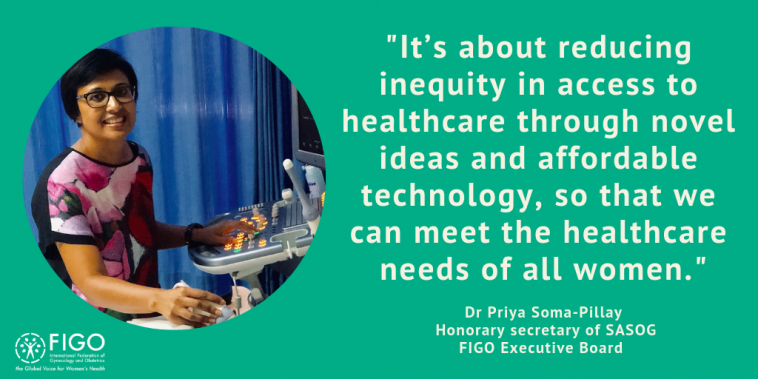Think Equal: women's health, South Africa

Ensuring equal access to public services, and ensuring those services respond to the specific needs of women’s health, is fundamental to reducing poverty, inequality, and advancing the rights of women and girls.
Unfortunately, millions of women and girls around the world still lack the fundamental services they need to ‘survive, thrive and transform,’ as set out in the Global Strategy for Women’s, Children’s and Adolescent’s Health.
As the global voice for women’s health, FIGO advocates for improved availability, accessibility and affordability of healthcare services that respond to the specific needs of women to ensure a lifetime of health and wellbeing.
Dr Priya Soma-Pillay, honorary secretary of SASOG (South African Society of Obstetricians and Gynaecologists), about the barriers she sees to equal access of public services and sustainable infrastructure in South Africa, and innovations that are raising the status of women.
Why is access to public services so important for the empowerment, health and wellbeing of women and girls?
It’s about reducing inequity in access to healthcare through novel ideas and affordable technology, so that we can meet the healthcare needs of all women.
In low- and middle-income countries (LMICs), women face a number of unique challenges. Some of the major obstacles that require innovative solutions include equal access to free education, and access to effective contraceptive services in a private, non-judgemental setting.
Education and choice are both essential for allowing women equal opportunities in society.
We also need innovative programmes to address specific healthcare needs of women, including extended coverage of existing prevention services that can control the cervical cancer epidemic.
It is essential that labour wards and maternity care are modified and technologically modernised, for both mental and physical wellbeing, for instance the accommodation of companions in labour. Ground-breaking research is required to identify and treat women with hypertensive disease in pregnancy.
There is often a dangerous gap in access to public services between women and men, particularly in rural areas. What is the biggest challenge you see for women in South Africa when it comes to accessing public service?
In South Africa, healthcare access for all is constitutionally enshrined - yet considerable inequities remain, largely due to the legacy of our discriminatory history.
Most of the public health care resources are utilised in urban areas, but a large percentage of women are based in rural areas. Access barriers include vast distances, no public transport, and high travel costs.
In a study of barriers to obstetric care at a tertiary hospital in South Africa, 66 percent of women who were classified as a ‘maternal near-miss’ encountered some form of delay before reaching the appropriate level of care. Several women with known pregnancy risk factors were unable to seek care even if they faced serious health risks. Others encountered life-threatening delays within the healthcare system. Many women were also unable to judge the severity of their disease pathology and only sought care once their condition became life threatening.
Unfortunately, the majority of women in LMICs are vulnerable by virtue of where they live and who they are. They carry the risk of increased maternal morbidity, which escalates further to a poor quality of life, aggravated by poor social circumstances and a heavy socio-economic burden.
How is SASOG working to advance gender equity in access to public services?
SASOG’s vision is to promote excellence and equity in women’s health while maintaining high ethical standards. Our BetterObs Programme is one of several initiatives aimed at promoting women’s health in South Africa, optimising maternal and fetal outcome by providing evidence-based care in the most efficient manner.
Interprofessional collaboration is also hugely important for quality maternal health, and so training midwives using the ESMOE (Essential Steps in Managing Obstetric Emergencies) is another integral component.
SASOG also plays an important role in specialist O&G training in South Africa. This includes funding research and laparascopic simulation training for registrars. Financial support is made available to academic heads of departments to convene annual meetings to discuss initiatives for teaching and learning.
OBGYNs are on the frontline of women’s health. What is the most exciting innovation you have seen when it comes to accelerating progress for gender equality in your field?
South Africa has one of the largest anti-retroviral therapy programs in the world. Approximately 30 percent of pregnant women attending public health clinics here are HIV infected, and so the provision of anti-retroviral treatment for all pregnant women in South Africa has significantly improved both maternal and childhood outcome.
Since the introduction of the prevention-of-mother-to-child-transmission (PMTCT) programme about 15 years ago, substantial reductions in vertical transmission rates have been observed. Strong national leadership and civil action has led to rising antenatal HIV testing uptake (more than 95 percent by 2016) and triple ART coverage (more than 93 percent by 2016).
Consequently the national risk of early (6 weeks postpartum) mother-to-child-transmission has significantly decreased: from approximately 25 – 30 percent prior to 2001, to 1.4% in 2016. Maternal mortality rates due to HIV disease also dropped by 47 percent between 2011 and 2016.
Knowing one’s HIV status allows for treatment and reduction of viral load, which decreases the risk of fetal transmission during pregnancy. HIV disease testing is now freely available at all clinics, and we see that HIV testing prior to pregnancy empowers women to make informed reproductive choices.